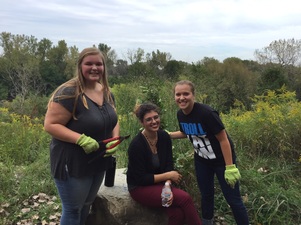|
I'm pleased to share a guest post from one of the students in my Environmental Science class.this semester.
Lake Katherine is one of the beauties of God’s creation set just outside of Chicago. Our class worked near the Cal-Sag trail and channel where lovers of nature and boaters come to embrace the fall scenery. Much of its landscape consists of milkweed, New-England aster, compass plant, and other native prairie species. However, many invasive species were also found such as buckthorn and honeysuckle. An invasive species is a plant or animal that is not native to an ecosystem that could cause harm to both humans and native species. Invasive species take up sun and space (growing room) for the native species, essentially killing them. Ecological restoration involves restoring damaged ecosystems with the help of humans. We aided in the ecological restoration of Lake Katherine by pulling the invasive species. As I learned, burning sometimes takes place at Lake Katherine to kill invasive species and allow for only native plants to grow back. In addition, we found many plastic bottles and cans, and properly disposed of them so chemicals from the plastic and aluminum do not affect any animals, plants, or water ways. We were trying to fix what was damaged (invasive species taking over the land and litter) and restore what was originally there (native species). By participating in ecological restoration, we are being stewards to God’s creation and taking care of what He has given us. ~Lauren Siston
0 Comments
Leave a Reply. |
Abbie SchrotenboerI'm a biology professor at Trinity Christian College. I'll be using this page to share interesting stories related to ecology and conservation at Trinity and in the Chicago area (although I might be tempted to expand my geographic focus upon occasion). Archives
December 2020
Categories |


 RSS Feed
RSS Feed
